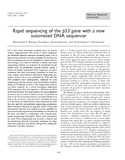| dc.description.abstract | p53 is the most commonly mutated gene in human cancers. Approximately 90% of the p53 gene mutations are localized between domains encoding exons 5 to 8. Sequencing methods currently available are tedious and time-consuming and are not suitable for routine laboratory testing. In an effort to identify a simple and rapid sequencing method, we analyzed 16 preselected breast tumors and 18 preselected ovarian tumors, using a newly developed automated DNA sequencer. p53 gene mutations had been previously identified in these tumors, using a conventional automated sequencing procedure. Exons 5 to 8 were amplified by PCR, and the PCR products were subsequently subjected to cycle sequencing with the Sanger chain termination method, using Cy5.5-labeled primers. The sequencing mixture was then resolved on a newly developed automated DNA sequencer that can sequence approximately 300 bases of DNA in 30 min. Of these 16 breast tumors, two had mutations in exon 5, four in exon 6, three in exon 7, and three in exon 8. Of the 18 ovarian tumors, two had mutations in exon 5, five in exon 6, two in exon 7, and three in exon 8. In all cases, we identified the same mutations by both the new and the conventional sequencing procedures. Most mutations affected an arginine codon. These data demonstrate that the new method has the capability to provide accurate sequencing information in a fraction of the time and labor in comparison with current automated sequencing techniques. When such procedures are used, DNA sequencing may become a routine tool for identifying clinically important mutations for diagnosis and prognosis of patients with genetic, malignant, infectious, and other diseases | en |


